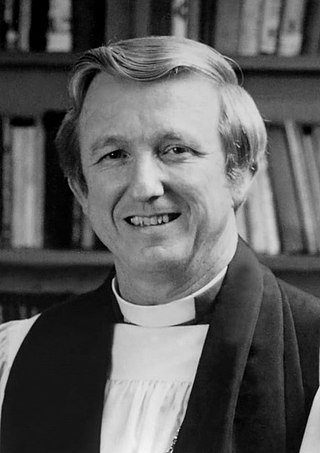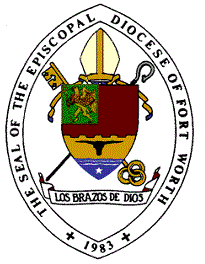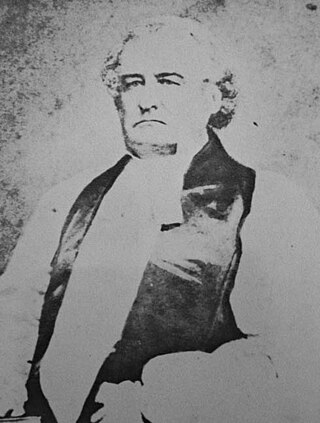Related Research Articles
An ecclesiastical court, also called court Christian or court spiritual, is any of certain courts having jurisdiction mainly in spiritual or religious matters. In the Middle Ages, these courts had much wider powers in many areas of Europe than before the development of nation states. They were experts in interpreting canon law, a basis of which was the Corpus Juris Civilis of Justinian, which is considered the source of the civil law legal tradition.
A presiding bishop is an ecclesiastical position in some denominations of Christianity.
A vicar general is the principal deputy of the bishop of a diocese for the exercise of administrative authority and possesses the title of local ordinary. As vicar of the bishop, the vicar general exercises the bishop's ordinary executive power over the entire diocese and, thus, is the highest official in a diocese or other particular church after the diocesan bishop or his equivalent in canon law.
The General Synod is the tricameral deliberative and legislative organ of the Church of England. The synod was instituted in 1970, replacing the Church Assembly, and is the culmination of a process of rediscovering self-government for the Church of England that had started in the 1850s.

The Episcopal Church in North Texas was a diocese of the Episcopal Church from 1982 to its merger with the Diocese of Texas in 2022. The diocese included a geographic area of 24 counties in the north central part of Texas. As of 2021, it includes 13 churches, including a number of other congregations in the process of reorganization. The jurisdiction was the site of a major schism in 2008. This schism was the result of the diocese's bishop, Jack Iker, leading the majority of clergy and parishes to join the Anglican Church of North America as the Episcopal Diocese of Fort Worth. The Episcopal Church diocese is headquartered in Fort Worth, Texas. It announced on April 22, 2022, that it would seek reunion with the Episcopal Diocese of Texas. The merger was finalized by the 80th General Convention of the Episcopal Church in the United States of America on July 11, 2022.

The Anglican Diocese of Quincy is a member of the Anglican Church in North America and is made up of 32 congregations, principally in Illinois but also in Wisconsin, Minnesota, Texas, Iowa, Nebraska, Missouri, Hawai'i, Colorado, Tennessee, and Florida in the United States. The diocese was a founding member of the Anglican Church in North America in 2009.

Edmond Lee Browning was an American bishop. He was the 24th presiding bishop and primate of the Episcopal Church in the United States of America.

The Episcopal Diocese of Pittsburgh is a diocese in the Episcopal Church in the United States of America. Geographically, it encompasses 11 counties in Western Pennsylvania. It was formed in 1865 by dividing the Episcopal Diocese of Pennsylvania. The diocesan cathedral is Trinity Cathedral in downtown Pittsburgh. The Rt. Rev. Ketlen A. Solak was consecrated and seated as its current bishop in autumn 2021.
The House of Deputies is one of the legislative houses of the bicameral General Convention of the Episcopal Church in the United States of America. The other is the House of Bishops.

The Episcopal Church of Cuba is a diocese of the Episcopal Church in the United States. The diocese consists of the entire country of Cuba. From 1966 to 2020, it was an extra-provincial diocese under the archbishop of Canterbury. As of 2021, it had nearly 1,600 members and an average worship attendance of more than 600 in forty-four parishes, including the Cathedral of the Holy Trinity in Havana.
In the United States, the history of the Episcopal Church has its origins in the Church of England, a church which stresses its continuity with the ancient Western church and claims to maintain apostolic succession. Its close links to the Crown led to its reorganization on an independent basis in the 1780s. In the nineteenth and early twentieth centuries, it was characterized sociologically by a disproportionately large number of high status Americans as well as English immigrants; for example, more than a quarter of all presidents of the United States have been Episcopalians. Although it was not among the leading participants of the abolitionist movement in the early 19th century, by the early 20th century its social engagement had increased to the point that it was an important participant in the Social Gospel movement, though it never provided much support for the Prohibitionist movement. Like other mainline churches in the United States, its membership decreased from the 1960s. This was also a period in which the church took a more open attitude on the role of women and toward homosexuality, while engaging in liturgical revision parallel to that of the Roman Catholic Church in the post Vatican II era.

The General Synod of the Anglican Church of Canada is the chief governing and legislative body of the Anglican Church of Canada (ACC), the sole Canadian representative of the Anglican Communion. The first General Synod session was held in Toronto in 1893, with the proviso that the parameters of its authority would not undermine the local independence of dioceses.
According to both Catholic and Anglican canon law, a cathedral chapter is a college of clerics (chapter) formed to advise a bishop and, in the case of a vacancy of the episcopal see in some countries, to govern the diocese during the vacancy. In the Catholic Church their creation is the purview of the Pope. They can be numbered, in which case they are provided with a fixed prebend, or unnumbered, in which case the bishop indicates the number of canons according to the rents. These chapters are made up of canons and other officers, while in the Church of England chapters now include a number of lay appointees. In some Church of England cathedrals there are two such bodies, the lesser and greater chapters, which have different functions. The smaller body usually consists of the residentiary members and is included in the larger one.

The Episcopal Church (TEC), based in the United States with additional dioceses elsewhere, is a member church of the worldwide Anglican Communion. It is a mainline Protestant denomination and is divided into nine provinces. The presiding bishop of the Episcopal Church is Michael Bruce Curry, the first African American bishop to serve in that position.

The Diocese of Quincy was a diocese of the Episcopal Church in western Illinois from 1877 to 2013. The cathedral seat was originally in Quincy, Illinois but was moved to St. Paul's Cathedral in Peoria in 1963. In order to avoid confusion with the Roman Catholic Diocese of Peoria, the diocese retained the name of the location of its original "home" city, Quincy, where its cathedral seat was St. John's.

The Episcopal Diocese of Fort Worth is a diocese of the Anglican Church in North America. The diocese comprises 56 congregations and its headquarters are in Fort Worth, Texas.

The Protestant Episcopal Church in the Confederate States of America was an Anglican Christian denomination which existed from 1861 to 1865. It was formed by Southern dioceses of the Episcopal Church in the United States during the American Civil War. When the Southern states seceded from the Union and established the Confederate States of America, it was not unusual for Protestant churches to split along national lines also. The Episcopalians were different as their separation was made only after the Confederacy was created and ended within six months of the South's surrender when Southern Episcopalians reunited with their counterparts in the North.

The Episcopal Diocese of South Carolina (EDOSC), known as The Episcopal Church in South Carolina from January 2013 until September 2019, is a diocese of the Episcopal Church. The diocese covers an area of 24 counties in the eastern part of the U.S. state of South Carolina. The see city is Charleston, home to Grace Church Cathedral and the diocesan headquarters. The western portion of the state forms the Episcopal Diocese of Upper South Carolina. As a diocese of the Episcopal Church, the Diocese of South Carolina is part of the worldwide Anglican Communion and traces its heritage to the beginnings of Christianity.
Church of South India Trust Association (CSITA) Director board is the highest administrative body of CSI. Synod is the annual general meeting of CSI. Moderator of the Synod is a Bishop who is a presiding officer of the election conducted in the Annual General Meeting. The elected board is normally to hold office for three years.
The Episcopal Diocese of South Carolina was established in 1785 as one of the nine original dioceses of the Episcopal Church in the United States. The diocese originally covered the entire state of South Carolina, but the western part of the state became the Episcopal Diocese of Upper South Carolina in 1922. In 2012, a controversy led to the existence of two rival dioceses, the Anglican Diocese of South Carolina and the Episcopal Diocese of South Carolina, each claiming to be the legitimate successor of the original diocese.
References
- ↑ The Episcopal Church, Constitution and Canons Constitution Article I Section 1
- ↑ Title I Canon 1 Section 3 (a)
- ↑ Constitution Article I Section 2
- ↑ Constitution Article I Section 4
- ↑ Title I Canon 2 Section 1
- ↑ Title I Canon 1 Section 7 (a-b)
- ↑ Title I Canon 1 Section 7 (a-b), 11.
- ↑ The Episcopal Church, Treasurer Archived 2011-01-06 at the Wayback Machine , accessed January 7, 2011.
- ↑ Title I Canon 1 Section 1 (j).
- ↑ The Episcopal Church, Executive Officer and Secretary Archived 2011-01-06 at the Wayback Machine , accessed January 6, 2011.
- ↑ Title I Canon 1 Section 13.
- ↑ Joint Rule IX
- ↑ Title I Canon 4
- ↑ Title I Canon 1 Section 2 (a-c)
- ↑ Title I Canon 1 Section 2 (n)
- ↑ Title I Canon 1 Section 2 (d-e)
- ↑ Title I Canon 1 Section 2 (h)
- ↑ William White (1782), The Case of the Episcopal Churches in the United States Considered: Chapter I, Project Canterbury, accessed January 8, 2011.
- ↑ Podmore, Colin (May 2008). "A Tale of Two Churches: The Ecclesiologies of The Episcopal Church and the Church of England Compared". International Journal for the Study of the Christian Church. 8 (2): 127. doi:10.1080/14742250801930822.
- ↑ Podmore 2008, pp. 128-129.
- ↑ James R. Gundrum, "The General Convention: Understood Authority or Ecclesiastical Chaos" Archived 2010-04-08 at the Library of Congress Web Archives, Arrington Lectures 1982, University of the South, p. 2.
- ↑ Podmore 2008, pp. 128.
- ↑ Podmore 2008, pp. 138.
- ↑ ENS Staff (July 7, 2015). "General Convention wrap-up: Historic actions, structural changes". Episcopal News Service. Retrieved 13 July 2015.
- ↑ Flynn, Anne-Gerard (July 16, 2018). "Episcopal convention advocates investing in gun companies". The Republican . Springfield, Massachusetts . Retrieved April 3, 2019.